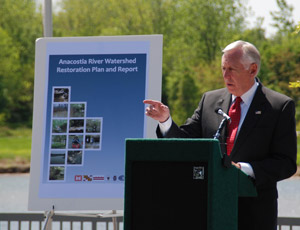The U.S Army Corps unveiled a $1.7-billion, 10-year plan this week to restore the ailing Anacostia River in the Washington, D.C. metropolitan area to health.

The plan, two years in the making, identifies 3,000 projects to help restore the severely polluted river and watershed spanning 176 sq miles of land through a combination of stormwater controls, stream restoration, wetland creation and restoration, fish blockage removal, reforestation and controlling trash and chemical contamination
“Now we can begin even more aggressive action to clean up the Anacostia River,” said U.S. House Majority Leader Steny Hoyer (D-Md.), who has championed the development of a plan to clean up the Anacostia in Congress, at an April 19 briefing.
The projects are being overseen by state and local agencies, as well as the U.S. Army Corps of Engineers, says Dana Minerva, executive director of the Anacostia Watershed Partnership. The Corps spent two years identifying projects to help clean up and restore the heavily polluted river to health.
One possible hiccup could be finding funding to pay for the projects. Funding for the plan was authorized under the Water Resources and Development Act of 2007, but Congress has yet to appropriate the money. But Minerva says she expects local county and state governments to step up and play a role. “We have a wide partnership and I expect that many entities will be contributing to the implementation of the plan.” Minerva adds that some projects are already underway, although the bulk of work lies ahead.
The plan is intended to work in concert with major federal and state efforts. For example, the D.C. Water and Sewer Authority has launched a $3-billion Long-Term Control Plan to significantly reduce combined sewer overflows that dump raw sewage into the Anacostia after heavy rains. Additionally, the Washington Suburban Sanitary Commission is implementing a $350 million program to reduce sanitary sewer overflows that discharge untreated sewage into the watershed.
At the briefing, Rep. Eleanor Holmes Norton (D-D.C.), said, “My regional colleagues and I are intent on following through with the executives of our jurisdiction and the Army Corps to begin implementation immediately.”


Post a comment to this article
Report Abusive Comment